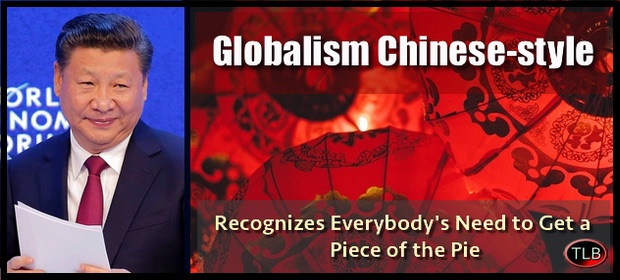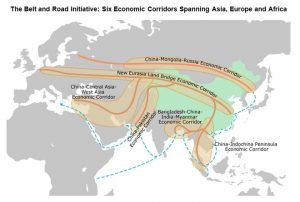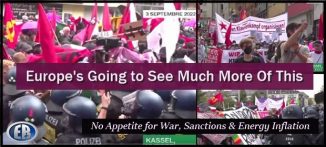
Liberalism is The Problem – Win-Win Globalism is The Solution
The term “globalism” means many different things to many different people. The definitions vary as much due to cultural factors as ideological ones. When the word first appeared in the common vernacular, it tended to have universally positive connotations which referred to the power of technology and the confluence of global trade to prevent world wars and bring nations closer together economically, culturally and diplomatically.
Since then, while the word has retained much of its original spirit in China and other Asian nations, in other parts of the world but particularly in Europe, the United States and the so-called “white (British) Commonwealth”, the word has taken on many negative connotations. For China, globalism is contrasted with economic insularity, competing nationalist and extremist geopolitical narratives and geo-economic caution. By contrast, in the west, globalism has become something of a catch all which can mean neo-liberal economics, so-called Cultural Marxist sociological programmes, elitism, so-called reverse racism and at more extreme levels it has become a code word for either a “vast Jewish conspiracy”, “vast global Illuminati” conspiracy or the “New World Order” as first articulated by US President George H.W. Bush in the early 1990s.
While everyone has the right to define categorically broad terms in the manner of their choosing, in reality insofar as geopolitical policy is concerned, today’s world has but two competing forms of globalism: A Chinese win-win model versus the western neo-liberal, zero-sum model.
Chinese globalism
China’s model of globalism when de-compartmentalised means the following:
–Promoting and advancing the cause of voluntary free trade and a general opening up of markets across a plethora of free trading zones and bilateral partnerships
–Working with partner nations on investment and development schemes which are tailored to the individuals needs and aspirations of any given individual partner
–Pursuing multilateral infrastructural and logistical development initiatives to make world  trade easier, cheaper and faster. The Belt and Road initiative is emblematic of this drive for more open trade
trade easier, cheaper and faster. The Belt and Road initiative is emblematic of this drive for more open trade
–Actively pursuing trade and investment into poor or developing nations and offering reasonable loans as a means of the most effect path towards peace and conflict resolution
Crucially, Chinese globalism is equally defined by what it is not. Chinese globalism does not seek to force any nations into any binding agreements for free trade as a means of unilateral leverage wherein a strong nation forces an un-sustainable agreement onto a weaker partner. China is willing to pursue agreements with nations based on collective decision making which can result in investment without trade, trade without loans, an opening of markets that falls well short of free trade or free trade with various restrictions, red lines and quotas. Of course, any combination of the aforementioned possibilities or beyond is entirely possible.
The key to Chinese globalism is that a refusal of China’s initial offer in any bilateral or multilateral negotiation does not force China away from the table. China is willing and has proved itself able to make deals according to that which any partner is comfortable with.
A related concept is that for China, agreements to pursue free trade, open up financial markets, invest in a partner nation’s development or setting up a credit line are in no way related to security agreements (those with or without China) and are equally unrelated to the style of governance in a nation partnering with China. China does not force partner nations to change any part of their national characteristics as a pre-requisite to an agreement. On the contrary, China works to enhance relations based on an understanding of national and regional characteristics.
Put simply, China’s method of doing business is a global version of the kinds of unemotional transactions an individual makes in his or her daily life wherein one has a goal in mind and one negotiates this with a shopkeeper, loan officer at a bank or a fellow company. In these sorts of transactions, the future style of business a partner pursues, the corporate structure of the company one is buying something from or selling something to and the ideological concerns of the negotiating partner do not factor into a straightforward transactional discussion. China operates the same way both in terms of Chinese corporations and of Chinese sovereign trade and financial agreements. This contrasts sharply with the western model of globalism.
Western neo-liberal globalism
Western globalist initiatives tend to prioritise lengthy/long-term agreements over a bespoke transactional approach. Furthermore, according to the neo-liberal model, western nations (particularly wealthy ones) prefer to conduct trading deals with countries that have similar neo-liberal systems. More often than  not, when partnering with a poorer or developing nation that is ill suited to neo-liberalism, a western trading agreement will force a weaker partner to adopt a neo-liberal economic system.
not, when partnering with a poorer or developing nation that is ill suited to neo-liberalism, a western trading agreement will force a weaker partner to adopt a neo-liberal economic system.
Most worryingly, many agreements drafted by major western nations and blocs make demands of new partners regarding their internal governance and their security relationships. For the US in particular, if a developing nation wants more trade and investment with the US, this often means that such a nation needs to renounce any and all pre-existing security agreements with countries Washington perceives as rivals. It also means that a partner nation is either coaxed or coerced into buying expensive American or other NATO built weapons even when more economically viable or better alternatives are readily available. The US but also the EU have also become ever more belligerent in their  willingness to use sanctions as a means of forcing such agreements upon “partner” nations in a form of geopolitical blackmail masquerading as commerce.
willingness to use sanctions as a means of forcing such agreements upon “partner” nations in a form of geopolitical blackmail masquerading as commerce.
Like Chinese globalism, western neo-liberal globalism is also defined by what it is not. Western neo-liberal globalism tends to prioritise a mandatory opening up of developing markets without making any guarantees for job security, developmental funds or fair credit lines to the poorer partner to an agreement. To put it bluntly, western globalist agreements are more concerned with rapidly getting US products onto foreign shelves while opening up a partner nation’s national resources to foreign exploitation on terms that are typically highly lopsided in favour of the wealthier partner.
While the Chinese method looks to increase employment and worker productivity in partner nations by investing in areas where a poorer partner has untapped potential, the US prefers to merely take advantage of existing capacities without thinking of a longer term sustainable relationship where a free trade agreement will create jobs on all sides rather than just one side. Because of this, the Chinese model continues to win hearts and minds throughout the developing world.
The Trump-Perot protectionist factor
In the 1990s, third party US Presidential candidate Ross Perot (pictured) talked about neo-liberal trading agreements creating a “giant sucking sound” which implied that high paying domestic industrial jobs would be lost due to free trading agreements.
 Perot’s diagnosis was correct, but regrettably, Perot’s economic acolytes including Donald Trump have misunderstood the reasons for this. While many neo-protectionists, including Donald Trump, blame China’s productivity for taking away US jobs, the reality is that it was the US and not China which pursued both domestic development and free trade agreements from the wrong perspective and thus did not create uniformly positive results.
Perot’s diagnosis was correct, but regrettably, Perot’s economic acolytes including Donald Trump have misunderstood the reasons for this. While many neo-protectionists, including Donald Trump, blame China’s productivity for taking away US jobs, the reality is that it was the US and not China which pursued both domestic development and free trade agreements from the wrong perspective and thus did not create uniformly positive results.
China is able to increasingly open its markets as a nation transitioning from a wealthy developing nation to a moderately prosperous one because the market socialist economic model allows for both the proceeds of domestic industry and wealth created through foreign transactions to be channelled back into the nation-state in the form of investment into further development and modernisation of industry, infrastructure building, social security programmes and human development whether in the fields of education, health, sport, arts and culture.
In the neo-liberal system, profits made in the US are allowed to leave the country with comparative ease while the domestic proceeds of foreign wealth brought into the US also are allowed to be sucked out without being re-invested in a proper way. Because of this, rather than using America’s vast wealth to reinvest in developing more modern industry as well as investing into society itself, America’s industrial colossus, which was once the envy of the world, remained frozen in time due to a combination lack of domestic investment, poor worker productivity, exceedingly poor educational standards when compared to much of Asia, and labor unions whose confrontational attitude was as regressive as the wilfully exploitative and uncooperative attitude of management.
 Ironically, the one area of the US industrial economy that operates on a model similar to China’s market-socialist system is the defence industry. Here, the private and public sectors work to pool investment capital into the research, development and manufacturing of new weapons, ships, vehicles and aircraft and likewise, the workforce in the defence sector is paid well but is also broadly selected based on ability, loyalty and good character.
Ironically, the one area of the US industrial economy that operates on a model similar to China’s market-socialist system is the defence industry. Here, the private and public sectors work to pool investment capital into the research, development and manufacturing of new weapons, ships, vehicles and aircraft and likewise, the workforce in the defence sector is paid well but is also broadly selected based on ability, loyalty and good character.
If the US did with its civilian sector what it continues to do in the military-industrial complex, the US would be more like China in terms of industrial competitiveness, modernisation, efficiency and the ability to make products people want – whether American consumers or those abroad. Again, one cannot blame China for America’s unwillingness to use its own defence industry model in the civilian/consumer sectors.
Likewise, US free trade agreements have hurt not only developing nations but have also sucked jobs out of the US because instead of working with other nations on the bespoke Chinese model to create jobs best suited to the characteristics and capacities of each partner nation, the US instead thought that a “one size fits all” model would somehow be sustainable.
China cannot be blamed for any of this as, unlike the US in the mid-20th century, China is preparing itself for future domestic investment via its market socialist system in which the profits of business make a ‘giant whooshing sound’ as they circulate, rather than a giant sucking sound as they disappear.
The automation factor
As more and more industrial jobs are replaced by robotics and artificial intelligence (AI), the Chinese model is becoming the only sustainable one available. In China, the market socialist system means that the wealth created by AI will be circulated back into the national economy in the same way that wealth generated by the human hand has done. This will free up more Chinese people to go into other fields, including research and development, while the machines take care of the more monotonous task of production. In neo-liberal economies, the profits made by AI will be subject to that familiar giant sucking sound and, once again, the US and EU will only have themselves to blame for creating an economic model that prioritises short term thinking over long term sustainability.
One of the many ways China can use its excellence in AI to help the developing world is by exporting robots to developing nations while working cooperatively with national partners to develop market socialist systems with individual characteristics so that citizens in developing nations can pursue employment in new commercial sectors while the wealth generated by Chinese robots in Africa, for example, could help Africans to generate wealth while using the wealth to advance social development in societies still rocked by post-colonial exploitation. The same also applies to the rapidly developing economies of south east Asia, south Asia and Latin America.
 Likewise, the Russian superpower has been keen to embrace the Chinese model to solve its own problems in the spheres of innovation, worker productivity and sustainable economic development across many sectors. To all the small-minded commentators who claim that under President Putin, Russia is “fighting globalism”, this is simply a lie. Russia is embracing Chinese style globalism with ever more vigour according to President Putin’s own words. Thus, if ill-informed commentators in the US think that Russia will help the far-right in the US and EU to regress towards protectionism and ultra-nationalism, they have been sold a pack of lies.
Likewise, the Russian superpower has been keen to embrace the Chinese model to solve its own problems in the spheres of innovation, worker productivity and sustainable economic development across many sectors. To all the small-minded commentators who claim that under President Putin, Russia is “fighting globalism”, this is simply a lie. Russia is embracing Chinese style globalism with ever more vigour according to President Putin’s own words. Thus, if ill-informed commentators in the US think that Russia will help the far-right in the US and EU to regress towards protectionism and ultra-nationalism, they have been sold a pack of lies.
Conclusion
The opposite of western neo-liberal globalism is not a retreat to old fashioned protectionism with nationalistic characteristics. Protectionism is just a simplistic way of denying the realities of the modern world by embracing outdated solutions. In reality, the opposite of western neo-liberal globalism is the Chinese model for globalism as it is one which can help countries both rich and poor to create more wealth in a sustainable fashion while maintaining their security independence, their national dignity and their political sovereignty. This is what Chinese President Xi Jinping means when he says “win-win”. The Chinese model offers all the benefits of what westerners think globalism is, while also incurring the benefits of what many westerners think is only possible through protectionism and ultra-nationalism.
We are all globalists now. The question therefore is are we going to be western neo-liberal globalists or win-win.
************
Original article




